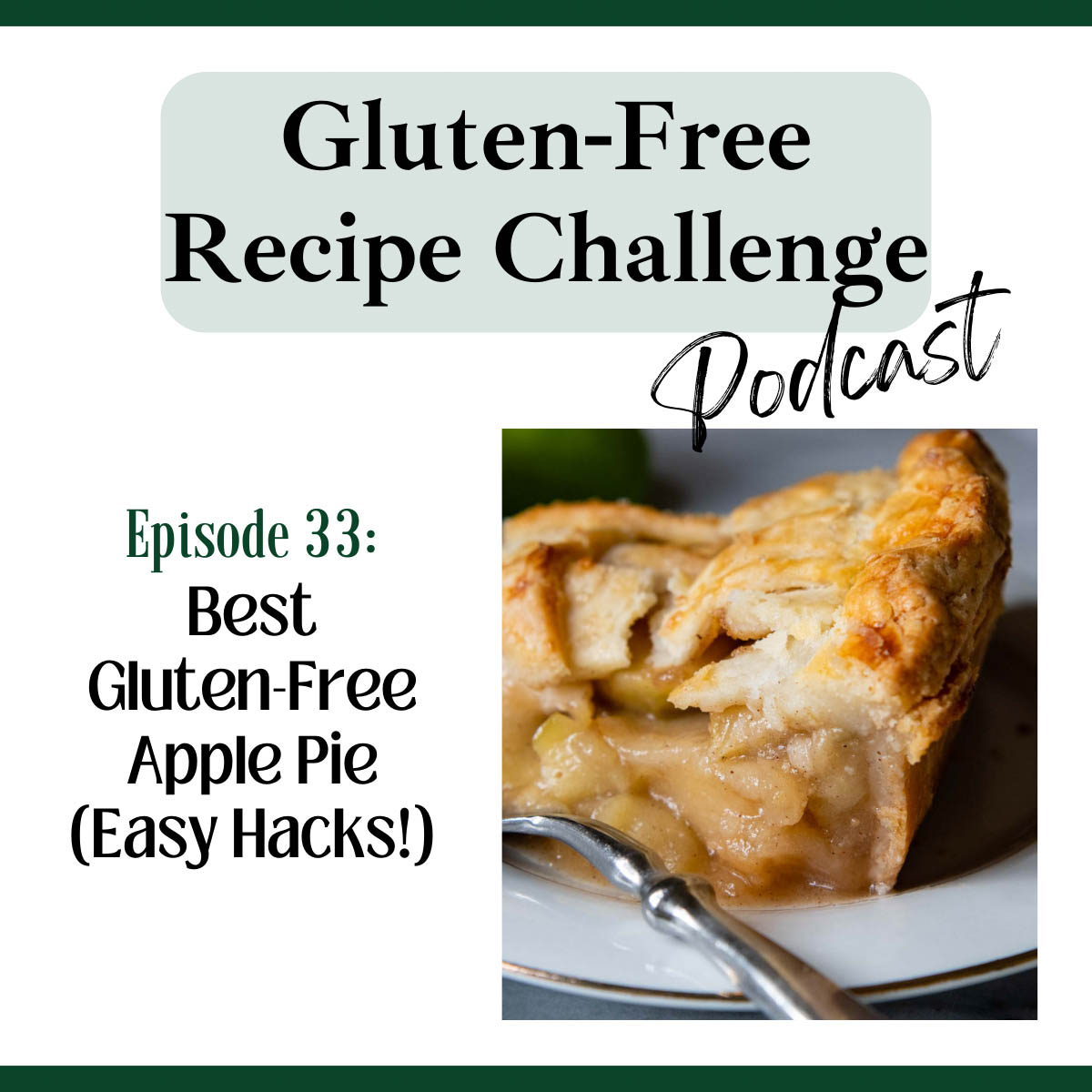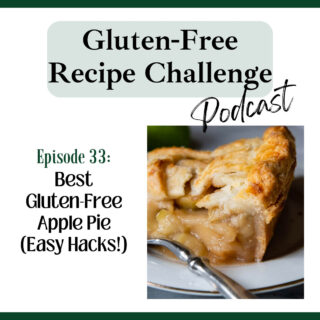In episode 33 discover easy hacks to make a gluten-free apple pie with a perfectly crisp bottom crust, flaky lattice top, and thick, perfectly tender apple filling. Join Melissa, gluten-free cookbook author, to make an audio recipe for gluten-free apple pie, using her easy, foolproof tricks!

Listen to this episode, along with the full audio library, on iTunes, Spotify, Stitcher, TuneIn, or your favorite podcast player.
Recipes and Resources Mentioned
Recommended Equipment
Recommended ingredients
Cup4Cup All Purpose Gluten-Free Flour
Follow Along
Don’t forget to subscribe to our weekly newsletter! Besides receiving an immediate GLUTEN-FREE BAKING BONUS, this weekly newsletter gives you direct access to the newest recipes, helping you with menu planning and exclusive tips!
Transcript
Hey everyone, I’m Melissa Erdelac, host of the Gluten free Recipe Challenge podcast and creator behind the gluten free website MamaGourmand. Here we take beloved recipes you thought you’d never enjoy again and transform them into easy copycat versions just as good as the originals.
Recently I went a little bit too much all in on making the most amazing gluten free apple pie and as it is with all things food with me, I really got obsessed with how to achieve all the best components. So what I wanted was a flaky crust but not only a flaky crust on top, but that bottom flaky crust, which is really hard to do with a gluten free pie. Then the filling had to be perfectly thickened and then also lots of apples, not skimping on the apples at all. Of course I wanted to top it all off with a lattice crust because even though it is actually pretty easy to do and looks very intimidating, it’s pretty badass and it makes you look like a badass while you’re at it.
So that’s what we’re going to go over today. We’re going to go over a perfectly cooked crust with apple filling that’s not too liquidy or mushy and just the right amount of apples, and then that golden double crust on top.
Okay, so first let’s talk about the filling. And the most important part of the filling is choosing the right apples. So when I tested this recipe, I don’t like my fillings to be overly sugary or syrupy, so I started off with using a mixture of Granny Smith apples and Golden Delicious, but actually, I felt like the Granny Smith apples were a little too tart for the amount of sugar I had in the recipe. So my number one recommendation for apples is using Golden Delicious. I feel like they’re the perfect balance of sweet and tart. They… also don’t break down or become mushy while they’re baking.
A couple of other varieties that would work well would be Honeycrisp, Jonagold, Braeburn, or Pink Ladies, and then if you do like a little tarter of a filling, you could do a combination of Granny Smith with any of these.
Okay, to make the filling, traditional apple pies, you slice up the apples, you mix it together with a little bit of sugar and the spices, and then some sort of thickener, which could be flour, or in this case I used cornstarch, and you pour it in the unbaked pie shell. What happens though is you have to bake it in a perfectly balanced way, where the apples are cooking at the same rate as the pastry.
So when it comes out of the oven, the filling is cooked long enough to be thickened, and then the apples are tender enough, which may or may not be the same time as the pastry. To avoid that problem, what I do is I partially cook the apples on the stove first with the thickener.
Saute the apples with the sugar, brown sugar, a little bit of butter, the spices, salt, and a little bit of lemon juice. Cook that over medium heat for about 15 minutes. The apples at this point should be slightly softened, but not breaking down or losing their shape at all.
Then mix together the cornstarch with a little water, pour that into the apple mixture and cook it for about another two minutes until the sauce is perfectly thickened. Remove it from the heat at this point and then stir in the vanilla extract. Your sauce will be thickened to the right consistency and when it finishes baking in the oven, that’s just to get the apples a little bit more tender.
Before you pour it into your unbaked pie crust though, the apples have to fully cool. So You can either set it out at room temperature for about an hour or so, stirring every few minutes, or to speed it up, you could lay it out on a baking sheet and put it in the fridge.
Okay, so next for your pie crust, you’ll want to use the pie crust recipe that I have on my website, Mamagourmand, and I’ll also link to it on the show notes page. This is my go to pie crust, and I would recommend it for any pie recipe. For this recipe in particular, you’re going to have to make a double recipe, so you have a top and a bottom crust.
The dough has to chill for at least an hour or two before you use it, so my recommendation would be to make the dough before you start the apple pie filling and let it chill in the fridge, or you could even make it the day before and store it well wrapped in the fridge until you’re ready to use it.
The best pie pan to use, and I’ll go into this a little bit later when I talk about how to make that crispy bottom crust, is a metal deep dish pie pan. For this recipe, I use five pounds of apples, which is a lot of apples to make that mile high apple pie, so you need a deep dish one that’s at least one and a half to two inches deep and nine inches in diameter.
Roll out the bottom crust, fit it into your pie pan and then go ahead and pour your cooled apples in. And then stick that back into the fridge while you work on the lattice top. I never let my pies sit on the counter If there’s any sort of lag time, I always transfer them back to the fridge because you want your pie crust to be cold as possible when you bake it, which also helps make it become flaky.
Okay, so for the lattice crust, I will do my best to talk you through this, but it’s actually a lot easier if you just look at the pictures for it, which I have on the recipe. I have a step by step how to do it. And it is not hard and it’s actually kind of fun.
Roll out your top crust, and then take a pizza cutter and you’re going to cut 12 one inch strips in that top crust. Lay six of the strips along the top of the pie, and you want to use the shorter strips on the ends, and then the longer ones in the middle.
Then fold back three alternating strips, so they’re almost like falling off the pie, and you’re gonna lay another strip right up against it. Fold those strips back over the pie, and then you’re gonna fold back the alternating strips. It’s just like weaving. If you ever did any weaving crafts when you were younger,
Put another strip across. Fold back the ones that were folded over, and repeat it until you have all the strips weaved together. So when you look at it, you’re going instinctively know which strip to use, because you want to fit the length of the strip that fits the width of the pie. So the shorter ones go towards the end, and then the longest one will go in the middle and then work back down.
Okay, so now fold under the crust together with those lattice edges so they’re seamed together. And once those edges are rolled over, then you could go ahead and make that decorative edge around the outside.
Beat together an egg with a little bit of milk, and I brush that over the top, which just makes the pie crust really shiny after it’s baked. And then if you want to go super profesh, sprinkle a little bit of coarse sugar on top. At this point, put your whole assembled pie in the freezer for at least 15 minutes before you bake it.
Let’s talk about how you’re going to get that crisp bottom crust when you have all that moisture from the five pounds of apples. The pie starts off baking at 400 degrees, which is a higher oven temp. Stick a metal baking sheet lined with parchment or foil on top. because that will catch the drips from the pie as it bubbles up.
Put that lined baking sheet in the oven and then preheat your oven to 400 degrees with the baking sheet. Once the oven’s preheated, you put the metal pie dish on the metal baking sheet and this is the biggest criteria for not having that soggy bottom layer. The two metals together are going to conduct a lot of heat onto that bottom pie crust, and that’s what makes it flaky.
You can also use this trick with a glass or ceramic pie dish, and the metal baking sheet will definitely help. But for the best results, it’s really ideal to use a metal pie pan.
Start at a high oven temperature, the 400 degrees, for the first half of the baking. And then, after 35 minutes, you’re going to leave the pie in the oven, but lower the temperature to 375.
It’s also a great idea to cover the edges of your pie with some sort of pie shield. I have like a silicone pie shield that I just place on top. Or you could use strips of aluminum foil, which gets to be a little bit of a pain in the ass, but you could do that if that’s all you have. But it’s really important to cover the edges of your pie because although we’re doing all this stuff to get the bottom and the sides really crispy, that top outer edge is just exposed. So you want to protect that.
The other thing that I do if I see that the pies becoming too browned on top before the apples are done is I’ll just loosely tent a piece of foil over the top as well.
So at that lower oven temperature, continue to bake it for 30 to 40 minutes and you’ll know when it’s done because the juices start to bubble up not just around the edges but through the vents in the middle too. And this is where you want that parchment paper, because when it bubbles up, it will bubble over onto the sheet.
Another important thing I want to mention is that this pie is best the day that it is made. That’s when the crust is the flakiest. I found that after it sits for two to three days, the crust gets a little softer.
So you have a couple options if you want to do this make ahead. One is you can make the pie dough the day ahead, make the apple pie filling the day ahead, and store it in the fridge and then just assemble it the day you’re going to serve it.
The other option is you could assemble the whole pie, freeze it before you bake it, and then once it’s frozen, then wrap it up with plastic wrap and then a layer of foil, and you could freeze it up to two months.
When you’re ready to bake, then unwrap it, and you would bake directly from frozen on that preheated baking tray. You do not thaw at first. You just want to bake it right from frozen. When you lower the oven temperature to the 375, it will require a little bit more time to bake just because the pie has to thaw first, it’ll take about 10 to 20 minutes additional baking time.
Remember you can find the full printable recipe on the show notes page, and to get to that just click click on the link provided in whatever podcast app you’re listening on or go to my recipe website, which is mamagourmand.Com and click on the podcast tab. And there you’ll find the full recipe along with any recommended ingredients or equipment I’ve talked about.


Leave a Reply